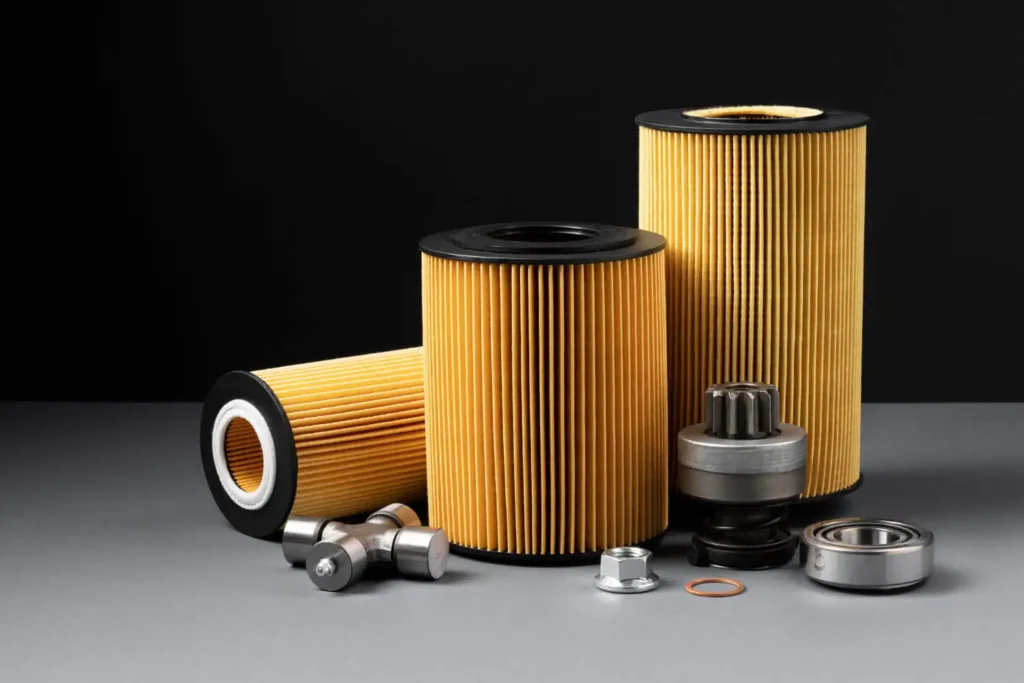
How our Air Oil Separator works? 5 Working principle of air oil separator
Keeping machinery efficient and clean is crucial for a variety of industrial applications. An air oil separator facilitates the process of separating oil from compressed air or gases. This part of the system is essential because contaminated air containing oil can cause malfunctions or damage to machinery. A solid understanding of the concepts and workings of an air oil separator can maximize machinery performance, extend component life, and guarantee operational efficiency.
What is an Air Oil Separator?
An air-oil separator is a piece of equipment used in engines and machinery that takes oil out of compressed gas or air before reusing it inside the system or releasing it into the environment. An oil separator, also called an oil demister, is a type of oil filter used to extract oil from oil-infused air in vacuum pumps, motors, screw compressors, and compressed air systems. As a fundamental component of the compressed air system, these separators are essential to maintaining the intake system’s effectiveness and safety.
What does an air oil separator do?
Air oil separators remove oil from greasy air to ensure its effective and secure operation of air compressors and the equipment and systems that require compressed air. In addition to ensuring the compressor operates efficiently, high-quality air oil separators increase the equipment’s lifespan, lower maintenance costs, and lower the failure rate. The air oil separator uses filters and baffles to extract the oil from the compressed air. The filters in the separator catch the oil and other impurities while allowing the air to pass through. After leaving the separator, the clean air is operational.
How Our Air Oil Separator Works
Air oil separators, often known as catch cans, have a fairly basic idea. Oil-filled air is directed into the filter via a slender pipe. Following a sharp turn from the input, the air leaves the filter through an outlet. The oil can rotate with the air, but the oil cannot, so it falls into the filter. Adding lower pressure to the filter vessel successfully removes a significant amount of the oil.
More complex designs have extra chambers and baffles inside the vessel, mainly catch cans and most air oil separators. It filters out more oil from the air. Still, the idea is the same: let the gasses infused with oil travel through a channel that restricts the flow of oil but not air. An air oil separator can be a beneficial addition for individuals prone to oil build-up in blow-by gasses. The following are some of the key benefits of utilizing this component:
- Stopping needless oil loss
- Stay away from oil Build-Up
- Better performance
- Reduced maintenance costs
Top Five Principles of Air Oil Separators
Principle 1: Filtration Process
In this case, the initial line of defense is the filtration process in an air oil separator. The compressed air that goes into the separator passes through a filter aimed at collecting large droplets of oil. It is crucial to do this first stage of filtering to eliminate most of the oil. It will allow the subsequent stages to focus on splitting the oil into smaller particles. The way filtration happens, therefore, determines how efficient an air-oil separator is and its ability to protect machinery from oil contamination.
Principle 2: Centrifugal Air Oil Separators
Using centrifugal force allows for efficient separation of oil from compressed air, making this type of device suited for situations requiring significant flow rates. As the oil-gas mixture rotates around the barrel, the centrifugal force subjects the denser oil particles to a more substantial impact due to their larger mass and motion. As a result, these oil particles gradually separate from the oil-gas mixture and continuously gather on the barrel wall, forming larger oil droplets that slide down the barrel wall. This technology can be used to remove tiny oil droplets that can pass past the initial filtration stage with great success.
Principle 3: Collision separation
Collision separation is when impact or collision separates oil particles from an air stream. As compressed air travels through the separator, it meets certain obstructions or surfaces that cause collision and attachment of the oil particle with those surfaces. The separated oil drains by gravity, allowing clean air to pass through the system. The technique of collision separation is beneficial in removing smaller oil droplets, which otherwise cannot be captured through filtration or centrifugal force.
Principle 4: Gravity sedimentation separation
To achieve air-liquid separation, relying on the differing relative densities and masses of oil and carbon dioxide is necessary. During the process of the air-oil mixture passing through the separator, the heavier oil particles will naturally settle to the bottom of the unit due to the force of gravity. Because it enables continuous separation and collection of oil without disrupting the airflow, this approach benefits systems containing significant quantities of oil. To attain the most excellent possible results, applying it in conjunction with the other two working principles is typically necessary.
Principle 5: Oil return circulation
The last concept of an air oil separator is oil return circulation, ensuring the separated oil is reused and managed efficiently. By internal pressure in the air oil separator barrel, the lubricating oil separated from the compressed air will collect at the bottom of the air oil separator barrel and the bottom of the air oil separator element. It will then be discharged from the air oil separator and re-enter the oil pipe system that circulates lubricating oil in the air compressor. Oil return circulation contributes to cost savings and environmental sustainability by preserving system efficiency and lowering the requirement for regular oil changes.
Conclusion
Using an air oil separator is vital to maximize the service life and efficiency of your machinery. Air oil separators are a fundamental component of all compressed air systems. They are essential in separating the oil in the compressed air and preventing oil carryover and oil loss contaminants from the compressed air system. If you understand their principles and operations, you can use them best to ensure your facility runs effectively and sustainably.

